Babak Hodjat
Unlocking the Potential of Global Human Expertise
Oct 31, 2024Abstract:Solving societal problems on a global scale requires the collection and processing of ideas and methods from diverse sets of international experts. As the number and diversity of human experts increase, so does the likelihood that elements in this collective knowledge can be combined and refined to discover novel and better solutions. However, it is difficult to identify, combine, and refine complementary information in an increasingly large and diverse knowledge base. This paper argues that artificial intelligence (AI) can play a crucial role in this process. An evolutionary AI framework, termed RHEA, fills this role by distilling knowledge from diverse models created by human experts into equivalent neural networks, which are then recombined and refined in a population-based search. The framework was implemented in a formal synthetic domain, demonstrating that it is transparent and systematic. It was then applied to the results of the XPRIZE Pandemic Response Challenge, in which over 100 teams of experts across 23 countries submitted models based on diverse methodologies to predict COVID-19 cases and suggest non-pharmaceutical intervention policies for 235 nations, states, and regions across the globe. Building upon this expert knowledge, by recombining and refining the 169 resulting policy suggestion models, RHEA discovered a broader and more effective set of policies than either AI or human experts alone, as evaluated based on real-world data. The results thus suggest that AI can play a crucial role in realizing the potential of human expertise in global problem-solving.
Discovering Effective Policies for Land-Use Planning
Nov 21, 2023Abstract:How areas of land are allocated for different uses, such as forests, urban, and agriculture, has a large effect on carbon balance, and therefore climate change. Based on available historical data on changes in land use and a simulation of carbon emissions/absorption, a surrogate model can be learned that makes it possible to evaluate the different options available to decision-makers efficiently. An evolutionary search process can then be used to discover effective land-use policies for specific locations. Such a system was built on the Project Resilience platform and evaluated with the Land-Use Harmonization dataset and the BLUE simulator. It generates Pareto fronts that trade off carbon impact and amount of change customized to different locations, thus providing a potentially useful tool for land-use planning.
Evolution of Transparent Explainable Rule-sets
Apr 21, 2022



Abstract:Most AI systems are black boxes generating reasonable outputs for given inputs. Some domains, however, have explainability and trustworthiness requirements that cannot be directly met by these approaches. Various methods have therefore been developed to interpret black-box models after training. This paper advocates an alternative approach where the models are transparent and explainable to begin with. This approach, EVOTER, evolves rule-sets based on simple logical expressions. The approach is evaluated in several prediction/classification and prescription/policy search domains with and without a surrogate. It is shown to discover meaningful rule sets that perform similarly to black-box models. The rules can provide insight to the domain, and make biases hidden in the data explicit. It may also be possible to edit them directly to remove biases and add constraints. EVOTER thus forms a promising foundation for building trustworthy AI systems for real-world applications in the future.
DIAS: A Domain-Independent Alife-Based Problem-Solving System
Mar 14, 2022



Abstract:A domain-independent problem-solving system based on principles of Artificial Life is introduced. In this system, DIAS, the input and output dimensions of the domain are laid out in a spatial medium. A population of actors, each seeing only part of this medium, solves problems collectively in it. The process is independent of the domain and can be implemented through different kinds of actors. Through a set of experiments on various problem domains, DIAS is shown able to solve problems with different dimensionality and complexity, to require no hyperparameter tuning for new problems, and to exhibit lifelong learning, i.e. adapt rapidly to run-time changes in the problem domain, and do it better than a standard non-collective approach. DIAS therefore demonstrates a role for Alife in building scalable, general, and adaptive problem-solving systems.
From Prediction to Prescription: AI-Based Optimization of Non-Pharmaceutical Interventions for the COVID-19 Pandemic
May 30, 2020
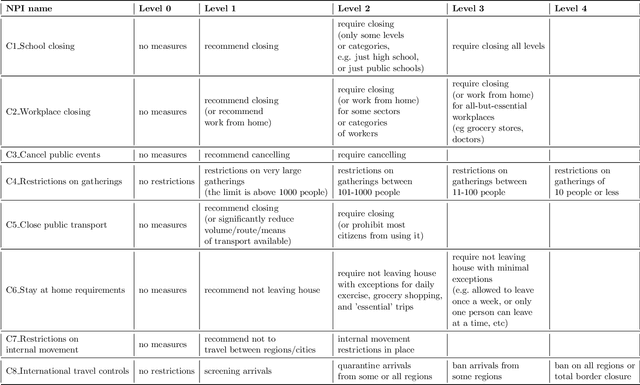
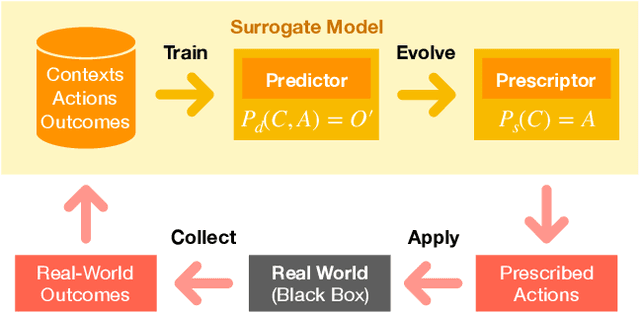

Abstract:Several models have been developed to predict how the COVID-19 pandemic spreads, and how it could be contained with non-pharmaceutical interventions (NPIs) such as social distancing restrictions and school and business closures. This paper demonstrates how evolutionary AI could be used to facilitate the next step, i.e. determining most effective intervention strategies automatically. Through evolutionary surrogate-assisted prescription (ESP), it is possible to generate a large number of candidate strategies and evaluate them with predictive models. In principle, strategies can be customized for different countries and locales, and balance the need to contain the pandemic and the need to minimize their economic impact. While still limited by available data, early experiments suggest that workplace and school restrictions are the most important and need to be designed carefully. It also demonstrates that results of lifting restrictions can be unreliable, and suggests creative ways in which restrictions can be implemented softly, e.g. by alternating them over time. As more data becomes available, the approach can be increasingly useful in dealing with COVID-19 as well as possible future pandemics.
Effective Reinforcement Learning through Evolutionary Surrogate-Assisted Prescription
Feb 13, 2020
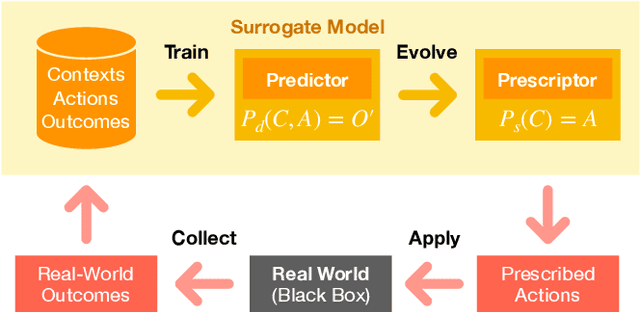

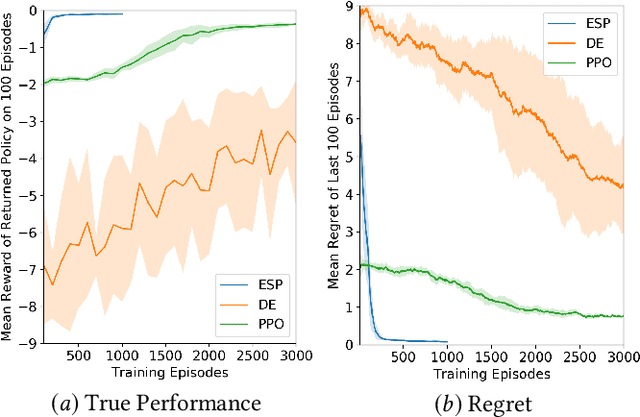
Abstract:There is now significant historical data available on decision making in organizations, consisting of the decision problem, what decisions were made, and how desirable the outcomes were. Using this data, it is possible to learn a surrogate model, and with that model, evolve a decision strategy that optimizes the outcomes. This paper introduces a general such approach, called Evolutionary Surrogate-Assisted Prescription, or ESP. The surrogate is, for example, a random forest or a neural network trained with gradient descent, and the strategy is a neural network that is evolved to maximize the predictions of the surrogate model. ESP is further extended in this paper to sequential decision-making tasks, which makes it possible to evaluate the framework in reinforcement learning (RL) benchmarks. Because the majority of evaluations are done on the surrogate, ESP is more sample efficient, has lower variance, and lower regret than standard RL approaches. Surprisingly, its solutions are also better because both the surrogate and the strategy network regularize the decision-making behavior. ESP thus forms a promising foundation to decision optimization in real-world problems.
Enhanced Optimization with Composite Objectives and Novelty Pulsation
Jun 07, 2019



Abstract:An important benefit of multi-objective search is that it maintains a diverse population of candidates, which helps in deceptive problems in particular. Not all diversity is useful, however: candidates that optimize only one objective while ignoring others are rarely helpful. A recent solution is to replace the original objectives by their linear combinations, thus focusing the search on the most useful trade-offs between objectives. To compensate for the loss of diversity, this transformation is accompanied by a selection mechanism that favors novelty. This paper improves this approach further by introducing novelty pulsation, i.e. a systematic method to alternate between novelty selection and local optimization. In the highly deceptive problem of discovering minimal sorting networks, it finds state-of-the-art solutions significantly faster than before. In fact, our method so far has established a new world record for the 20-lines sorting network with 91 comparators. In the real-world problem of stock trading, it discovers solutions that generalize significantly better on unseen data. Composite Novelty Pulsation is therefore a promising approach to solving deceptive real-world problems through multi-objective optimization.
Better Future through AI: Avoiding Pitfalls and Guiding AI Towards its Full Potential
May 30, 2019
Abstract:Artificial Intelligence (AI) technology is rapidly changing many areas of society. While there is tremendous potential in this transition, there are several pitfalls as well. Using the history of computing and the world-wide web as a guide, in this article we identify those pitfalls and actions that lead AI development to its full potential. If done right, AI will be instrumental in achieving the goals we set for economy, society, and the world in general.
Evolutionary Neural AutoML for Deep Learning
Apr 09, 2019



Abstract:Deep neural networks (DNNs) have produced state-of-the-art results in many benchmarks and problem domains. However, the success of DNNs depends on the proper configuration of its architecture and hyperparameters. Such a configuration is difficult and as a result, DNNs are often not used to their full potential. In addition, DNNs in commercial applications often need to satisfy real-world design constraints such as size or number of parameters. To make configuration easier, automatic machine learning (AutoML) systems for deep learning have been developed, focusing mostly on optimization of hyperparameters. This paper takes AutoML a step further. It introduces an evolutionary AutoML framework called LEAF that not only optimizes hyperparameters but also network architectures and the size of the network. LEAF makes use of both state-of-the-art evolutionary algorithms (EAs) and distributed computing frameworks. Experimental results on medical image classification and natural language analysis show that the framework can be used to achieve state-of-the-art performance. In particular, LEAF demonstrates that architecture optimization provides a significant boost over hyperparameter optimization, and that networks can be minimized at the same time with little drop in performance. LEAF therefore forms a foundation for democratizing and improving AI, as well as making AI practical in future applications.
The Surprising Creativity of Digital Evolution: A Collection of Anecdotes from the Evolutionary Computation and Artificial Life Research Communities
Aug 14, 2018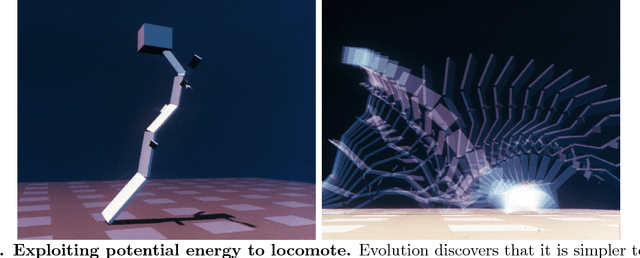


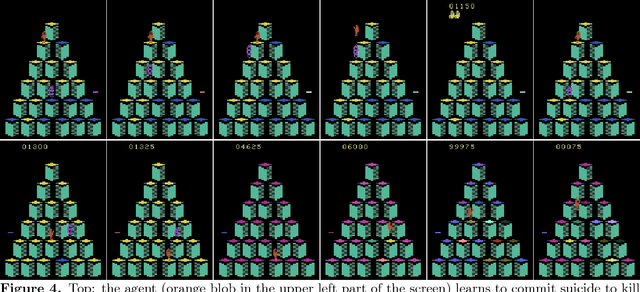
Abstract:Biological evolution provides a creative fount of complex and subtle adaptations, often surprising the scientists who discover them. However, because evolution is an algorithmic process that transcends the substrate in which it occurs, evolution's creativity is not limited to nature. Indeed, many researchers in the field of digital evolution have observed their evolving algorithms and organisms subverting their intentions, exposing unrecognized bugs in their code, producing unexpected adaptations, or exhibiting outcomes uncannily convergent with ones in nature. Such stories routinely reveal creativity by evolution in these digital worlds, but they rarely fit into the standard scientific narrative. Instead they are often treated as mere obstacles to be overcome, rather than results that warrant study in their own right. The stories themselves are traded among researchers through oral tradition, but that mode of information transmission is inefficient and prone to error and outright loss. Moreover, the fact that these stories tend to be shared only among practitioners means that many natural scientists do not realize how interesting and lifelike digital organisms are and how natural their evolution can be. To our knowledge, no collection of such anecdotes has been published before. This paper is the crowd-sourced product of researchers in the fields of artificial life and evolutionary computation who have provided first-hand accounts of such cases. It thus serves as a written, fact-checked collection of scientifically important and even entertaining stories. In doing so we also present here substantial evidence that the existence and importance of evolutionary surprises extends beyond the natural world, and may indeed be a universal property of all complex evolving systems.
 Add to Chrome
Add to Chrome Add to Firefox
Add to Firefox Add to Edge
Add to Edge